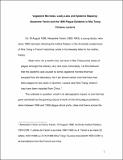Files in this item
Vagabond microbes, leaky laboratories and epidemic mapping : Alexandre Yersin and the 1898 plague epidemic in Nha Trang
Item metadata
| dc.contributor.author | Lynteris, Christos | |
| dc.date.accessioned | 2021-07-15T23:38:32Z | |
| dc.date.available | 2021-07-15T23:38:32Z | |
| dc.date.issued | 2021-02 | |
| dc.identifier | 257664503 | |
| dc.identifier | fed34089-63f5-4216-98b7-9d5bb762aa31 | |
| dc.identifier | 000649385200009 | |
| dc.identifier | 85115982026 | |
| dc.identifier.citation | Lynteris , C 2021 , ' Vagabond microbes, leaky laboratories and epidemic mapping : Alexandre Yersin and the 1898 plague epidemic in Nha Trang ' , Social History of Medicine , vol. 34 , no. 1 , pp. 190-213 . https://doi.org/10.1093/shm/hkz053 | en |
| dc.identifier.issn | 0951-631X | |
| dc.identifier.other | ORCID: /0000-0001-8397-0050/work/60630764 | |
| dc.identifier.uri | https://hdl.handle.net/10023/23582 | |
| dc.description | Research leading to this article was funded by a European Research Council Starting Grant under the European Union’s Seventh Framework Programme/ERC grant agreement no 336564 for the project Visual Representations of the Third Plague Pandemic. | en |
| dc.description.abstract | This article examines the epidemic mapping produced by the Pasteurian doctor Alexandre Yersin in the course of the outbreak of bubonic plague in the town of Nha Trang (French Indochina, 1898). Examining how Yersin responded to and reasoned about the outbreak as this unfolded around his laboratory, the article argues for a situated, processual approach of epidemic mapping. Considering four maps produced by Yersin during the outbreak, it is argued that these should not be simply seen as visual objects aimed at establishing and systematising epidemiological knowledge. Instead the changes evinced in and between these maps were driven by Yersin’s desire to distance plague from his laboratory, which stood accused as the origin of the epidemic. It is thus argued that, in this case, epidemic mapping acquires a distancing function, with its aim being to symbolically banish the source of the outbreak back to China. | |
| dc.format.extent | 24 | |
| dc.format.extent | 391466 | |
| dc.language.iso | eng | |
| dc.relation.ispartof | Social History of Medicine | en |
| dc.subject | Plague | en |
| dc.subject | Cartography | en |
| dc.subject | Colonial | en |
| dc.subject | Indochina | en |
| dc.subject | DS Asia | en |
| dc.subject | RA Public aspects of medicine | en |
| dc.subject | T-NDAS | en |
| dc.subject.lcc | DS | en |
| dc.subject.lcc | RA | en |
| dc.title | Vagabond microbes, leaky laboratories and epidemic mapping : Alexandre Yersin and the 1898 plague epidemic in Nha Trang | en |
| dc.type | Journal article | en |
| dc.contributor.sponsor | European Research Council | en |
| dc.contributor.institution | University of St Andrews. Social Anthropology | en |
| dc.identifier.doi | https://doi.org/10.1093/shm/hkz053 | |
| dc.description.status | Peer reviewed | en |
| dc.date.embargoedUntil | 2021-07-16 | |
| dc.identifier.grantnumber | 336564 | en |
This item appears in the following Collection(s)
Items in the St Andrews Research Repository are protected by copyright, with all rights reserved, unless otherwise indicated.

